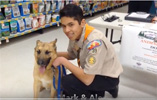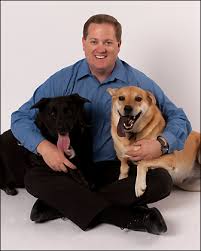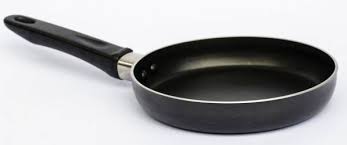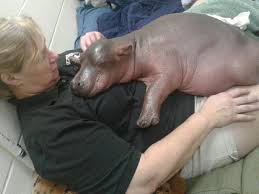Drone Is A Game Changer For Lost Pets
Kenneth Hendrick
 Hobbyist Kenneth Hendrick specifically bought his flying camera drone to look for lost pets in Florida. Teaming up with a Loxahatchee Lost and Found Pets Inc., in Florida, they search for up to 95 animals a month. He says he reunites pet parents with cats, dogs, pigs, turtles and even calves.
Hobbyist Kenneth Hendrick specifically bought his flying camera drone to look for lost pets in Florida. Teaming up with a Loxahatchee Lost and Found Pets Inc., in Florida, they search for up to 95 animals a month. He says he reunites pet parents with cats, dogs, pigs, turtles and even calves.
Kenneth states that there are a lot of inaccessible places where people can't go where he lives to search for animals. He felt that from the air he would be able to cut down on the amount of time that people were spending driving up and down the streets looking for animals and that he might be able to spot them a lot faster. He is also able to scan the canals, to make sure an animal hasn't fallen into a canal, which you can't do on foot.
Kenneth has partnered with Gail Bass and her friends Michelle French and Dawn DiBari. Gail Bass created a Facebook page four years ago, the Loxahatchee Lost and Found Pets, and it's grown to a membership of more than 10,000 Facebook users.mmTogether they reunite an average of 85 lost pets with their owners every month in the Loxahatchee area.
That sounds like a lot of lost animals, but Kenneth explains that there are a lot of animals out in the country where he lives. People might have two or three dogs and many cats. There was even a lost horse, and Kenneth states if he had known about it a day or so earlier, they might have been able to save the horse.
So where does he start to look for an animals? Kenneth tells us he starts his search at the last place the animal was seen. His drone has an HD video camera on it, which allows him to see things in real time. Whenever the drone is launched, it can stay up for half an hour and go about five miles before it has to come down to have the batteries changed.
Kenneth has been able to find many pets this way. However, he states that while the drone can locate the animal, it still takes Gail, Michelle and Dawn to go crawling through the woods and through the canals to actually retrieve the animals.
Kenneth doesn't charge for his animal locating services. While people who have lost their pets love his service, Kenneth's neighbors don't. They feel he is intruding on their space. He tells us he doesn't even look at their property; he just needs to cross it to get to another location. Plus, flying a drone takes practice, which he needs to constantly do. He also explains that you need both a pilot's license as well as a drone license to fly a drone, which he has.
Kenneth tells us he hopes this practice will start taking place all over the country.
Boy Scout Serves as a Role Model Animal Advocate
Alex Quintero, Boy Scout
 Alex Quintero is a Boy Scout from Troop 39 in the Grand Canyon Council District 66. Alex was the first Boy Scout to create an Eagle Service Project assisting shelter animals, entitled 'Animals R Family 2."
Alex Quintero is a Boy Scout from Troop 39 in the Grand Canyon Council District 66. Alex was the first Boy Scout to create an Eagle Service Project assisting shelter animals, entitled 'Animals R Family 2."
The Eagle Scout Service Project, or more simply the Eagle Project, was the opportunity for a Boy Scout, Varsity Scout, or qualified Venturer in the Boy Scouts of America (BSA) to demonstrate leadership of others while performing a project for the benefit of his community.
Alex's Eagle Project taught the community how to love their pets, because he tells us that animals are part of families. These animals should be treated as family members and they are not disposable.
This project was dear to Alex's heart because he loves the animals at his local shelter. His project was also unique, because it became a way for him to live his life. He is saving the lives of countless homeless animals and he will forever promote the message that animals are family too and that every animal deserves a loving home.
To complete his project, Alex collected food and supplies for pets, which include dog food, cat food, toy and blankets. He not only collected supplies for the local shelter, he also gave supplies to foster families to take care of the animals.
Alex visits the Coconino Humane Society in Flagstaff, Arizona, and gets to know the dogs real well by taking them for walks. He also grooms them to make them more presentable to a possible adopter and is also present to help out on adoption events.
At home, Alex has a foster dog, named Kodiak, as well as his own two German Shepherds. When his Eagle Project is complete, he will continue to foster dogs.
Alex is a true pioneer and says it feels great when people think of him as a role model and that he wasn't looking to be a role model when he started his project.
Most Eagle Projects are focused on improving a structure that helps the community. This could include building a shed or fence. They usually take a weekend or two to complete, or even just a couple of hours. However Alex's project took several months. But, it will never end for Alex, as he will always support shelter animals!
Check out Alex's Facebook page where he is promotin animals available for adoption.
E-Cigarette Toxicity in Pets - Dr. Debbie
 Think that vapor cigarettes (a.k.a. electric cigarettes or e-cigarettes) are a healthier alternative to traditional cigarettes? The vapor habit might be better for you and decrease your pet's exposure to second hand smoke, but can increase the chance of a pet's toxic ingestion of nicotine. A story from England told of the tragic death of a puppy that died after chewing on an e-liquid container.
Think that vapor cigarettes (a.k.a. electric cigarettes or e-cigarettes) are a healthier alternative to traditional cigarettes? The vapor habit might be better for you and decrease your pet's exposure to second hand smoke, but can increase the chance of a pet's toxic ingestion of nicotine. A story from England told of the tragic death of a puppy that died after chewing on an e-liquid container.
Ivy was a 14 week on Staffordshire Bull Terrier that chewed on her owner's bottle of e-liquid used to refill the electric cigarettes. Within 30 seconds of nibbling on the container, she fell sick with vomiting and disorientation and was rushed to a veterinary office. Sadly Ivy died within 24 hours due to heart and respiratory failure.
What's in e-liquid?
The ingredients in e-liquid vary but include carriers such as propylene glycol, polyethylene Glycol 400 and vegetable glycerin, as well as flavoring agents and nicotine. The amount of nicotine in e-liquid varies with some products not containing any nicotine, to others ranging from 18 mg/ml to 100mg/ml.
How toxic is nicotine?
The toxic dose of nicotine for pets is 0.5 to 1mg per pound of body weight. The fatal dose is 4mg per pound. So if you consider a 20 pound dog, toxicity would occur if 10mg were ingested, and the pet would die if 80mg were ingested. Therefore with the high nicotine levels in e-liquid, it wont take much to reach those fatal levels. That hypothetical 20 pound dog could die from less than 1ml of the highest potency liquid nicotine.
 Pets likewise can develop toxicity if other sources of nicotine are ingested such as cigarettes, chewing tobacco, nicotine gum, or nicotine nasal sprays. The typical amounts of nicotine in these products are: Cigarette 9-30 mg; Nicotine gum 2 - 4 mg per pieces; and Nicotine patches 8.3 - 114 mg.
Pets likewise can develop toxicity if other sources of nicotine are ingested such as cigarettes, chewing tobacco, nicotine gum, or nicotine nasal sprays. The typical amounts of nicotine in these products are: Cigarette 9-30 mg; Nicotine gum 2 - 4 mg per pieces; and Nicotine patches 8.3 - 114 mg.
Even cigarette butts can be toxic if enough are ingested - cigarette butts retain 25-percent of the nicotine in the original cigarette.
What are symptoms of nicotine poisoning?
Symptoms usually develop within one hour of ingestion. Pets may display excitability, rapid heart rate, drooling, vomiting, diarrhea, weakness, seizures, and coma.
How are pets treated for nicotine toxicity?
The first step is to decontaminate by inducing vomiting. Nicotine typically causes vomiting when ingested, but further decontamination is advised at the veterinary office. Other emergency care includes intravenous fluids, medications to manage elevated blood pressure and heart rate, and anti-seizure medications. Nicotine is metabolized by the liver and excreted within 16 hours after ingestion. Pets that survive the initial four hours after ingestion have a favorable chance of survival.
The vapor cigarette trend is becoming more popular world wide. It's important to recognize that nicotine is a toxin and poisonous to animals and children. Consider the e-liquid a hazardous material and store it safely in a locking cabinet, away from children and pets.
To read more about Ivy's toxicity after ingesting E-fluid go to "Dog dies after chewing e-fluid container."
Featured veterinarian known as "Dr. Debbie" on national pet radio program, Animal Radio. Ebook author of "Yorkshire Terriers: How to Be Your Dog's Best Friend"; "Pugs: How to Be Your Dog's Best Friend"; "Mini Schnauzers: How to Be Your Dog's Best Friend"; and "Shih Tzu: How to Be Your Dog's Best Friend." Dr. Debbie's books.
Visit Website
5 Dangerous Household Hazards For Pet Birds
Robert Semrow, Listomania
 Birds are really remarkable pets that can fill a home with love, laughter and entertainment. They are interactive and intelligent. Unfortunately, they are also susceptible to household dangers that are very common in many homes. So, I thought I would share some of these dangers that exist before they bring harm to a pet bird in your life.
Birds are really remarkable pets that can fill a home with love, laughter and entertainment. They are interactive and intelligent. Unfortunately, they are also susceptible to household dangers that are very common in many homes. So, I thought I would share some of these dangers that exist before they bring harm to a pet bird in your life.
Tragically, birds are very susceptible to toxic fumes and air from a variety of areas of your home. Many are surprised to learn that non-stick and Teflon-coated frying pans can emit a toxic gas that can kill a pet bird. Additionally, fumes from household cleaners, deodorizers and sprays can be equally as dangerous. It goes without saying, though I'm going to say it for my bird friends - vigilance and an abundance of caution must be used around your bird and their habitat. They are very sensitive to small amounts of toxins and the effects occur quickly.
Next is the danger that occurs when birds are allowed to fly with unclipped wings around the home. Sadly, each year we hear stories of birds being let out of their cage to "stretch their wings" and they fly themselves right out an open window or door and their owners are devastated. Additionally, birds can fly around and land in troublesome areas that can harm them like stoves or fly into to a ceiling fan, mirrors or even very clean windows. The damage is severe and it can easily be avoided.
Next are foods. Toxic foods like Chocolates, garlic, onions and more can be very harmful to your bird's system. Again, if your bird is allowed out of its cage, you have to watch them like a, well, you know what I was going to say. The area that your bird has access to will be explored by them and this can lead to problems if they get into human foods. Make it a 'must do' to know what human foods your bird can and can't have. And remember, that sharing food or using your utensils to cut a bird's food is also dangerous, as we can pass on dangerous bacteria and other organisms that can put a bird's life at risk.
 It should go without saying, but medications left around where a bird can get to it and ingest it are a tragic occurrence. Keep your medications in a safe area and only take them in that area.
It should go without saying, but medications left around where a bird can get to it and ingest it are a tragic occurrence. Keep your medications in a safe area and only take them in that area.
Finally, and this comes from the "Can't we all just get along files," birds are especially susceptible to danger from other pets, kids and strangers in the home. Everyone is fascinated by birds. Unfortunately, dogs and cats in particular are hazards that, intentionally or not, can cause great harm to your bird. Kids and strangers are fascinated, but it is your job to make sure that their interactions with your bird are safe, for the bird and for them.
Share your pet bird safety tips on our Animal Radio Facebook Page.
Visit Website
Animal Radio News - Lori Brooks
 Most Poplar Dog Breeds
Most Poplar Dog Breeds
Labrador Retrievers have extended their record run as America's most popular dog breed, leading the American Kennel Club's new rankings for over 26 years. But Rottweilers are enjoying renewed favor and have been striding up the popularity ladder, posting its highest ranking in almost 20 years. The complete Top 10 List of Popular Dog Breeds: Labs at #1; followed by the second most popular breed in the country - German Shepherds; Golden Retrievers come in at #3; the fourth most popular breed is the English Bulldog; next are the Beagle and French Bulldog at #5 & #6; Poodles take 7th place on the list; followed by Rottweiler's 8th place; Yorkshire Terriers at #9; and Boxers round out the top ten. Some other breeds making sizeable moves in the past decade: Siberian huskies are up from 25th to 12th; great Danes are up from 24th to 14th; and Australian shepherds are up from 34th to 16th. And keep an eye on the Belgian Malinois, which sprang from 90th to 47th, as it became increasingly visible in the U.S. as a police dog. Trivia Question: The only breed to rank in the top 10 every decade since the AKC was founded in the 1880s? Answer: The Beagle.
 Cat Masters "Switcher" Cup Game
Cat Masters "Switcher" Cup Game
A talented cat mastered the old switcheroo cup and ball gambling trick known as the "shell game" or "old army game." The cat, named Snow, can consistently identify which one of several cups contains a small plastic ball after they have been shuffled and moved around. Snow's owner has posted several videos showing him intently watching the shuffling cups before he quickly placing his paw on one and knocking it over to reveal the hidden ball. Snow is a pretty special cat. While Snow is known for his ability to seek out a plastic ball from underneath as many as five cups, his Instagram also features him dressed in some handsome sweaters and other outfits as well as showing off his cat-shaped fur pattern on his belly.
Federal Agents Kill Millions of Animals Every Year - Including Pets
Every year, federal agents kill millions of animals across the country, including 154,943 in the state of Washington alone last year. The agency responsible is the little-known Wildlife Services of the U.S. Department of Agriculture, which for public and private sector clients, kills animals all over the country from ravens, swans and doves to wolves, which are deemed a "problem" by the client. The agency, however, made unwelcome news when a 14-year old boy was injured and his 3- year-old yellow Lab named Casey was killed by a cyanide trap set by Wildlife Services intended to kill coyotes in Idaho. The trap was spring-activated and smeared with bait. It shoots cyanide into an animal's mouth when touched. The trap was set to control predator populations in an effort to limit livestock losses, according to the agency. In all, 15 pets were inadvertently killed by the agency in 2016 alone. It also intentionally targeted and killed dozens of species of wildlife, from bears to red foxes, sand hill cranes, a dozen species of doves and 415 gray wolves. When accidents like this happen, it draws attention and investigations let us know that the agency uses everything from neck snares and foothold traps to helicopters and firearms to capture animals.
 "Grumpy Dog"
"Grumpy Dog"
We are certain you've heard of Grumpy Cat. But there is also the story of a not so happy looking, adorable dog who finally found a home after winning hearts on the internet in his role as "Grumpy Dog." His name is Sheldon. Sadly, he was brought into an Arizona animal shelter, but his grumpy face didn't get him any adopters. Luckily, a volunteer shelter photographer took some great pictures of Sheldon showcasing his special look. His photos were shared everywhere and quickly earned the hashtag #GrumpyDog. When his soon to be new mom saw the photos, she rushed to the shelter the next day. So Sheldon has a new home and a new name, Cas, as well as 5 rescued cat siblings.
Baltimore's Cat Cafe
Cat cafes are becoming all the rage and Baltimore now has one too, one of those great special spots where people can stop by and have some coffee in the company of adoptable cats. Baltimore's nickname is Charm City, so Cam Tucker opened the Charm Kitty Café. Tucker said, "It gets cats out of cages and it increases adoption for local shelters." Charm Kitty Cafe houses at least seven cats at any given time and they roam free throughout the 1,150-square-foot space until they are adopted. Tucker said he visited cat cafes in Washington, D.C. and Colorado and learned from their successes and failures. What sets Charm Kitty apart from cat cafes in other cities is its design as a co-working office. Most cat cafes accept reservations with time limits for customers to enjoy the cats and cuisine. Charm Kitty will still take reservations in the evenings and on weekends, but weekdays from 10 a.m. to 5 p.m. the cafe will be open to about 30 co-working members.
 Preemie Baby Hippo is Doing Well
Preemie Baby Hippo is Doing Well
The Cincinnati Zoo's preemie baby hippo, Fiona is getting more independent and now tops over 100 pounds, meaning her days of napping on her human caretakers' laps will soon be over. When Fiona was born at the zoo, she weighed just 29 pounds, far below the typical weight of a newborn hippo. Caretakers scaled back their time with her in a transition phase as they moved toward integrating her into a group of hippos with her parents. QUESTION: How much does a full-grown hippo weigh? Answer: Hippos can grow to be 3,000 pounds!
 Listen to the entire Podcast of this show (#1129)
Listen to the entire Podcast of this show (#1129)





